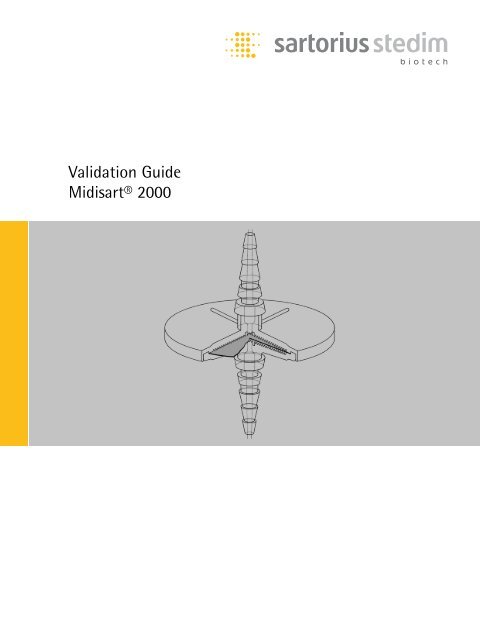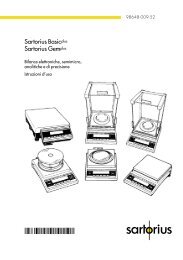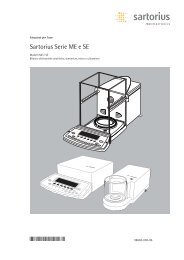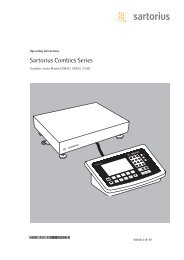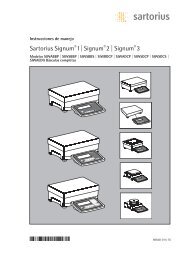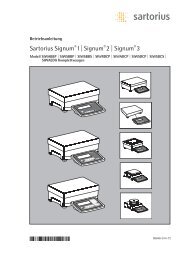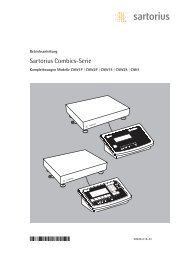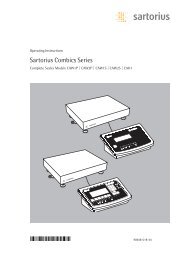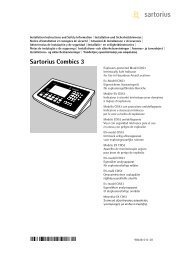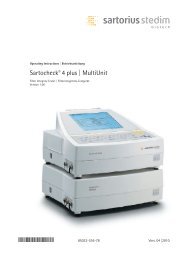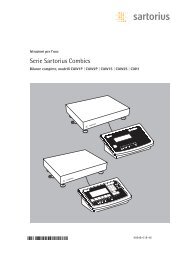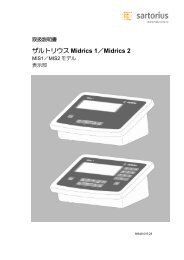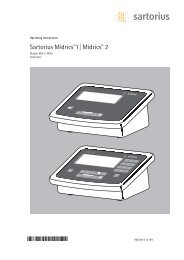Valid Midisart SLD5702-e - Sartorius AG
Valid Midisart SLD5702-e - Sartorius AG
Valid Midisart SLD5702-e - Sartorius AG
Create successful ePaper yourself
Turn your PDF publications into a flip-book with our unique Google optimized e-Paper software.
<strong>Valid</strong>ation Guide<br />
<strong>Midisart</strong>® 2000
Table of Contents<br />
1. Introduction 4<br />
1.1 cGMP Quality from <strong>Sartorius</strong> 5<br />
1.2 Quality Assurance 5<br />
1.3 Prevention of Contamination 5<br />
1.4 Complete Traceability 5<br />
1.5 <strong>Sartorius</strong> Drug Master File –<br />
DMF 5967 5<br />
1.6 DIN EN ISO Certificate 5<br />
1.7 Test Methods for the<br />
Quality Assurance of<br />
<strong>Midisart</strong>® 2000 Filter Elements 6<br />
2. Technical Specifications 7<br />
2.1 Product Description and Application 7<br />
2.2 Order Information 8<br />
2.3 Specifications 9<br />
3. Chemical Compatibility –<br />
<strong>Midisart</strong>® 10<br />
4. Determination<br />
of Integrity Test Data 11<br />
4.1 Basis for the Determination<br />
of Integrity Test Values 11<br />
4.2 Bacteria Challenge Test 11<br />
4.3 Bubble Point Test Limits 12<br />
4.4 <strong>Valid</strong>ation of Drying Procedure<br />
after Integrity Test IPA 60 % 14<br />
4.5 <strong>Valid</strong>ation of Drying Procedure<br />
after Integrity Test IPA 99.99 % 18<br />
5. <strong>Valid</strong>ation of Resistance<br />
to Repeated Autoclaving<br />
Cycles 134 ° C/30 min. 22<br />
5.1 Biocompatibility 24<br />
5.2 Storage Conditions 24<br />
6. Endotoxin Test 25<br />
| 3
1. Introduction<br />
4 |<br />
Pharmaceutical products, such as<br />
injectable and infusion solutions or<br />
those which come in contact with<br />
open wounds, must conform to<br />
exactly defined quality standards.<br />
The desired quality of the final<br />
product can only be obtained when<br />
the entire production process is<br />
adequately safeguarded against<br />
contamination. Final product<br />
quality meeting the standards of<br />
the respective pharmacopeias can<br />
be achieved by using membrane<br />
filter technology at critical points<br />
where particles or microbes could<br />
contaminate a product or must be<br />
separated from it. Heat-stable final<br />
products can be sterilized practically<br />
and effectively by autoclaving. This<br />
process, however, does not remove<br />
particles or dead micro organisms<br />
which may release pyrogens.<br />
Therefore, a prior membrane<br />
filtration run is required by cGMP<br />
regulations (Current Good Manufacturing<br />
Practice of the US Food and<br />
Drug Administration) to ensure that<br />
particles and microbes are removed.<br />
Solutions containing heat-labile<br />
products, such as anti biotics, can<br />
be cold sterilized by membrane<br />
filtration immediately before aseptic<br />
filing. Microbe retentive filtration<br />
(bacteria retentive according to<br />
the European Pharmacopeia 2<br />
and DAB 10) or sterile filtration in<br />
conformance with the current USP,<br />
respectively, is an important process<br />
step in the manufacture of sterile<br />
pharmaceutical products.<br />
When sterilizing filters are used in<br />
the manufacture of pharmaceuticals,<br />
the aseptic process must be<br />
validated, taking all aspects of the<br />
product and the production process<br />
into consideration. <strong>Midisart</strong>®, filter<br />
with a hydrophobic PTFE membrane,<br />
reliably fulfills the product-specific<br />
requirements which have to be<br />
imposed on a sterilizing grade filter<br />
both for gas and liquid filtration.<br />
<strong>Valid</strong>ation is indispensable for<br />
guaranteeing the safety of<br />
pharmaceuticals, being a logical<br />
supplement and significant part of<br />
the cGMP regulations which have<br />
been in force for quite some time.<br />
Guidelines for validation are given<br />
in the US Code of Federal Regulations<br />
Title 21 and the current<br />
USP. In addition, guidelines have<br />
been established jointly by the<br />
Committee for Laboratories and<br />
Official Drug Product Inspection<br />
Services and the Department of<br />
Industrial Pharmacists of the Federation<br />
Internationale Pharmaceutique<br />
(F.I.P.), which is the European<br />
counterpart of the FDA. The term<br />
validation is defined by the F.I.P.<br />
guidelines as follows: “<strong>Valid</strong>ation, as<br />
used in these guidelines, comprises<br />
the systematic testing of essential<br />
production steps and equipement<br />
in the R & D and production<br />
departments, including testing<br />
and inspection of pharmaceutical<br />
products with the goal of ensuring<br />
that the finished products can be<br />
manufactured reliably and reproducibly<br />
and in the desired quality<br />
in keeping with the established<br />
production and quality control<br />
procedures”.<br />
We have compiled this validation<br />
guide so users of <strong>Midisart</strong>® filter<br />
can plan, implement and document<br />
their own validation procedures.
1.1 cGMP Quality from <strong>Sartorius</strong><br />
Consistent high quality of <strong>Sartorius</strong><br />
Membrane Filters Disposables<br />
Capsules (ready-to-connect<br />
filtration units) and Filter Cartridges<br />
is assured by careful selection of<br />
the raw materials, wellplaned and<br />
validated production technologies<br />
and an excepionally efficient<br />
Quality Assurance Department, all<br />
of which results in high batchto-batch<br />
reproducibility. The test<br />
procedures used are based both on<br />
external standard methods, such<br />
as the USP, EP and ASTM, and on<br />
in-house methods which are the<br />
result of <strong>Sartorius</strong> experience over<br />
the past years.<br />
<strong>Midisart</strong>® filters are completely<br />
manufactured under clean-room<br />
conditions.<br />
1.2 Quality Assurance<br />
For quality assurance, all materials<br />
are selected carefully in accordance<br />
with current regulations, such as<br />
the FDA, CFR’s, CGMP’s, in-house<br />
guidelines and the specifications<br />
of our Research and Development<br />
Department including the terms<br />
of delivery and acceptance of our<br />
Purchasing Department. Documentation<br />
begins with the inspection<br />
of the incoming raw materials<br />
including in-process materials,<br />
molded parts and sealing materials,<br />
etc. for manufacture. Adherence to<br />
cGMP requirements (clean-room<br />
conditions, gowning and employee<br />
hygiene, etc.) which are monitored<br />
by documented in-process controls,<br />
ensures optimal quality control<br />
in standard operating procedures<br />
for production. Finished <strong>Sartorius</strong><br />
Disposables Capsules and Filter<br />
Cartridges undergo final product<br />
quality control. This involves<br />
100 % non-destructive testing, e.g.<br />
integrity testing, of each individual<br />
product. Other individual tests, e.g.<br />
Pyrogen Test, are carried out on a<br />
representative number of samples.<br />
A lot is not released until all<br />
in-process and final quality control<br />
data are available.<br />
1.3 Prevention of Contamination<br />
<strong>Sartorius</strong> sterile <strong>Midisart</strong>® are sealed<br />
in gas-permeable protective plastic<br />
bags under clean room conditions<br />
in the production area. Following<br />
this step, they are sterilized with<br />
Ethylene Oxide.<br />
1.4 Complete Traceability<br />
The pore size type and lot number<br />
are printed on the label of the<br />
protective plastic bag and on<br />
the label of the box in which the<br />
cartridge or capsule is packed. In<br />
addition, these specifications are<br />
imprinted on the end cap of each<br />
Sartofluor filter cartridge or on<br />
the housing of each capsule. The<br />
traceable lot number allows convenient<br />
retrieval of all data compiled<br />
on the materials used, production<br />
steps and QC tests.<br />
1.5 <strong>Sartorius</strong> Drug Master File – DMF<br />
5967<br />
In compliance with Title 21 Code of<br />
Federal Regulations (CFR) 314.420,<br />
the required information has been<br />
filed in the <strong>Sartorius</strong> Drug Master<br />
File – DMF 5967 under the heading<br />
“Sartoflour Mini Cartridge and<br />
Capsule <strong>Valid</strong>ation Guide” at the<br />
US Food and Drug Administration<br />
(FDA).<br />
1.6 DIN EN ISO Certificate<br />
The complete Quality Systems<br />
Certificates are continuously<br />
updated and can be downloaded on<br />
our website:<br />
www.sartorius-stedim.com/<br />
qm-certificates<br />
| 5
1.7 Test Methods for the Quality<br />
Assurance of <strong>Midisart</strong>® 2000<br />
Filter Elements<br />
The following tests are routinely<br />
carried out on each batch.<br />
6 |<br />
Raw materials<br />
(random sample test):<br />
Plastic housing parts<br />
a) Visual appearance<br />
b) Dimensions<br />
c) Particle contamination<br />
Membrane filters<br />
a) Visual control<br />
b) Thickness<br />
c) Flow rates for isopropanol<br />
100 %, air<br />
d) Bubble Point with isopropanol<br />
100 %<br />
Intermediate product<br />
(random sample test):<br />
a) Membrane sealing<br />
(membrane, sealing edge, housing)<br />
b) Membrane integrity<br />
Final product<br />
(100 % test):<br />
Each unit is tested during<br />
manufacture for membrane and<br />
housing integrity by a leakage test<br />
under automatic conditions.<br />
Final product<br />
(random sample test):<br />
Final control<br />
a) Visual appearance<br />
b) Housing burst pressure<br />
c) Pressure hold test with ethanol<br />
d) Bubble Point<br />
e) Flow rate for air<br />
f) Bacteria Challenge Test<br />
g) Housing leakage test
2. Technical Specifications<br />
2.1 Product Description and<br />
Application<br />
<strong>Midisart</strong>® 2000 ready-to-connect<br />
filtration units consist of a hydrophobic<br />
(PTFE) membrane filter in<br />
a polypropylene housing. They are<br />
available with 0.2 µm and<br />
0.45 µm pore size membranes, and<br />
are ideally suitable for all small<br />
scale air|gas sterilizing purposes,<br />
such as:<br />
the sterile venting of filling vessels<br />
and fermentation carboys including<br />
culture vessels<br />
the venting of holding tanks for<br />
sterile, distilled water and liquid<br />
culture media<br />
autoclave venting<br />
the in-line sterilization of and<br />
particulate removal from air and<br />
gases.<br />
The excellent chemical stability of<br />
these practical units also makes<br />
them useful for particle removal<br />
from chemicals and organic<br />
solvents.<br />
<strong>Midisart</strong>® units can also be used for<br />
the filtration of aqueous liquids, but<br />
the hydrophobic PTFE membrane<br />
filter must first be wetted with<br />
a watermiscible solvent such as<br />
ethanol. It may be necessary to<br />
repeat this wetting, e.g. if the<br />
filtration is interrupted.<br />
A further application is as a pump<br />
protector in vacuum lines. Please<br />
note, when using the unit as a<br />
protective barrier in a vacuum<br />
line (positioned between a suction<br />
flask and an electrical pump, to<br />
stop and overflow of filtrate from<br />
an over filled suction flask) or<br />
connected to a water jet pump (to<br />
stop a water backflash) the flat<br />
side with the lot number must face<br />
away from the vacuum source. On<br />
longer use, water can condense in<br />
the pores, so increasing the air flow<br />
resistance, with a consequent drop<br />
in the speed of filtration.<br />
This can be remedied by either<br />
blowing the <strong>Midisart</strong>® dry (1.9 bar<br />
for 5 min) or by drying it at 80 °C<br />
for 8 hours.<br />
| 7
2.2 Order Information<br />
8 |<br />
Order Numbers Pore Size [µm] Membrane Connectors E|A Pieces/Case Sterile<br />
17804 E 0.45 PTFE Hose Barb|Hose Barb 12 Yes<br />
17804 G 0.45 PTFE Hose Barb|Hose Barb 25 Yes<br />
17804 NPE 0.45 PTFE 1/8"| 1/8" NPT 12 Yes<br />
17804 NPG 0.45 PTFE 1/8"| 1/8" NPT 25 Yes<br />
17805 E 0.2 PTFE Hose Barb|Hose Barb 12 Yes<br />
17805 G 0.2 PTFE Hose Barb|Hose Barb 25 Yes<br />
17805 NPE 0.2 PTFE 1/8"| 1/8" NPT 12 Yes<br />
17805 NPG 0.2 PTFE 1/8"| 1/8" NPT 25 Yes<br />
17805 UPN 0.2 PTFE Hose Barb|Hose Barb 100 No<br />
17805 UPQ 0.2 PTFE Hose Barb|Hose Barb 500 No<br />
17809 UNN 0.2 PTFE 1/8"| 1/8" NPT 100 No<br />
17812 UNN 0.2 PTFE 1/8"|Hose Barb 100 No<br />
17805 TCN 0.2 PTFE TriClamp|TriClamp 100 No<br />
17877 UPN 0.2 PTFE Small Hose Barb| Small Hose Barb 100 No<br />
In the interest of further development of <strong>Sartorius</strong> Stedim biotech products, we reserve the right to make changes without notice.<br />
Standard Hose Barb Small Hose Barb<br />
1/8" NPT Thread TriClamp
2.3 Specifications<br />
Filter Material:<br />
PTFE reinforced with<br />
polypropylene gauze<br />
Housing Material:<br />
Polypropylene<br />
Filtration Area:<br />
20 cm 2<br />
Housing Diameter:<br />
64 mm<br />
Max. Operating Pressure:<br />
3 bar (2 bar in reverse direction)<br />
Water Penetration Point:<br />
4 bar (0.2 µm)<br />
Max. Temperature (autoclave):<br />
134 ° C<br />
Biosafety:<br />
Materials pass current USP Plastics,<br />
class VI<br />
Typical Air Flow Rates<br />
Weight:<br />
20 g<br />
Lot Number and Individual Unit<br />
Number:<br />
printed on the top part of each<br />
<strong>Midisart</strong>®-housing<br />
Inlet and Outlet:<br />
cleary indicated on <strong>Midisart</strong>®<br />
housing<br />
Box of 100-with:<br />
Memory disc included<br />
Priming Volume:<br />
approx. 3 mL<br />
Hold-up Volume:<br />
approx. 1 mL<br />
Presterilized with:<br />
Ethylene oxide<br />
Sterilization Method:<br />
Multiple autoclaving cycles allowed.<br />
<strong>Midisart</strong>® 2000 is not suitable for<br />
sterilization by gamma irradiation.<br />
If required, please use <strong>Midisart</strong>® BV<br />
instead.<br />
Flow Rate for Air at Pore Size 0.2 µm [L/min] Pore Size 0.45 µm [L/min]<br />
D p = 0.02 bar 1.1 1.8<br />
D p = 0.05 bar 2.9 4.6<br />
D p = 0.1 bar 5.0 8.5<br />
1 bar = 100 kPa = 14.5 psi<br />
| 9
3. Chemical Compatibility – <strong>Midisart</strong>®<br />
10 |<br />
Media:<br />
Acetic acid (concentrated)<br />
Acetone<br />
Acelonitrile<br />
n-Butanol<br />
Cellosolve (ethyl)<br />
Chloroform<br />
Diethyl acetamide<br />
Dimethylformamide<br />
Dimethylsulfoxide<br />
Dioxane<br />
Ethyl acetate<br />
Ethanol<br />
Ethylene glycol<br />
Freon TF<br />
Gasoline<br />
1 N Hydrochloric acid<br />
Hexane<br />
Isobutanol<br />
Methanol<br />
Methylene chloride<br />
Methyl ethyl ether<br />
Methyl ethyl ketone<br />
Pentone<br />
Sodium hydroxide (5 %)<br />
Tetrahydrofuron<br />
Toluene<br />
Trichloracelic acid<br />
Trichlorethane<br />
Water<br />
Xylene<br />
The materials (PP and PTFE ) used in<br />
<strong>Midisart</strong>® give it excellent compatibility<br />
with the products listed<br />
below. However, its compatibility<br />
can be affected by various factors,<br />
such as temperature, concentration,<br />
composition, etc. We therefore<br />
recommend that you test whether<br />
<strong>Midisart</strong>® is compatible with the<br />
particular medium you wish to<br />
filter.
4. Determination of Integrity Test Data<br />
4.1 Basis for the Determination of<br />
Integrity Test Values<br />
Objective:<br />
To correlate the microbial retention<br />
efficiency of <strong>Midisart</strong>® 2000<br />
filtration units to a practical,<br />
non-destructive integrity test.<br />
According to the Health Industry<br />
Manufacturers´ Association (HIMA)<br />
regulations of 1983 and the FDA<br />
“Guideline on sterile drug products<br />
produced by aseptic processing,<br />
June 1987”, a filter for sterilizing<br />
filtration, when challenged with a<br />
minimum concentration of<br />
10 7 Brevundimonas diminuta<br />
organisms/cm 2 of filter surface,<br />
must procedure a sterile filtrate.<br />
Since the Bacteria Challenge Test<br />
is a destructive method, it must be<br />
correlated with a non-destructive<br />
test by forming a test series.<br />
The FDA “Guideline on sterile drug<br />
products produced by aseptic<br />
processing, June 1987”, states:<br />
“After a filtration process is<br />
properly validated for a given<br />
product, process and filter, it is<br />
important to assure that identical<br />
filter replacement (membrane or<br />
cartridge) used in production runs<br />
will perform in the same manner.<br />
One way of achieving this is to<br />
correlate filter performance data<br />
with filter integrity testing data.<br />
Normally, integrity testing of the<br />
filter is performed after the filter<br />
unit is assembled and sterilized prior<br />
to use. More importantly, however,<br />
such testing should be conducted<br />
after the filter is used in order to<br />
detect any filter leaks of perforations<br />
that may have occurred<br />
during the filtration.”<br />
4.2 Bacteria Challenge Test<br />
Method:<br />
<strong>Midisart</strong>® 2000 ready-to-connect<br />
filtration units containing PTFE<br />
membrane filters of 0.2 micron<br />
pore size (order no. 17805), taken<br />
from different production lots, were<br />
subjected to a Bacteria Challenge<br />
Test in accordance with the HIMA<br />
document no. 3, Vol. 4 (April 1982).<br />
“Microbiological evaluation of<br />
filters for sterilizing liquids”, but at<br />
the higher test pressure of<br />
3.0 bar, corresponding to the<br />
maximum recommended operating<br />
pressure of these units. The set was<br />
carried out on units as supplied<br />
and on units subjected to various<br />
numbers of autoclavings.<br />
Test organism:<br />
Brevundimonas diminuta<br />
(ATCC 19146)<br />
Challenge:<br />
> 3 ƒ 10 8 organisms per <strong>Midisart</strong>®<br />
2000 (effective filter area 20 cm 2 ).<br />
Integrity Test:<br />
Before the challenge these units<br />
were integrity tested by the bubble<br />
point method in order to correlate<br />
the results of the challenge with<br />
those of a non-destructive integrity<br />
test. The given values are valid for<br />
<strong>Midisart</strong>® 2000 completely wetted<br />
with isopropanol 60 %.<br />
The bubble point test is performed<br />
by two different methods:<br />
Utilizing a Sartocheck® automated<br />
integrity test unit<br />
Manual, visual determination<br />
For determination of the bubble<br />
point, air pressure is slowly<br />
increased on the upstream-side of<br />
the <strong>Midisart</strong>® 2000 filters.<br />
The bubble point is the pressure at<br />
which a given liquid in the wetted<br />
pores of a membrane is forcibly<br />
removed. The removal of the liquid<br />
allows free flow of air through the<br />
membrane.<br />
The Sartocheck® units use<br />
algorithms for automatic detection<br />
of the BP. For the visual test, a tube<br />
is attached to the <strong>Midisart</strong>® outlet.<br />
This tube ends in a waterfilled<br />
vessel. When the first continuous<br />
stream of bubbles appears, the<br />
bubble point is detected.<br />
| 11
4.3 Bubble Point Test Limits<br />
Typical Results<br />
12 |<br />
”<strong>Midisart</strong>® 2000" Number of Bubble Point in bar Results<br />
17805 autoclaving (20 ° C) with Bacteria<br />
Lot Number cycles (121 ° C) Isopropanol 60 % Challenge Test<br />
003|9 0 1.6 sterile<br />
5 1.4 sterile<br />
10 1.4 sterile<br />
15 1.4 sterile<br />
004|9 0 1.5 sterile<br />
5 1.3 sterile<br />
10 1.3 sterile<br />
15 1.3 sterile<br />
006|9 0 1.4 sterile<br />
5 1.2 sterile<br />
10 1.2 sterile<br />
15 1.1 sterile<br />
008|9 0 1.6 sterile<br />
5 1.4 sterile<br />
10 1.4 sterile<br />
15 1.4 sterile<br />
011|9 0 1.3 sterile<br />
5 1.1 sterile<br />
10 1.0 sterile<br />
15 0.7 sterile<br />
Conclusion<br />
All results showed that <strong>Midisart</strong>®<br />
2000 units with a bubble point<br />
equal to, or larger than 0.7 bar<br />
retain the test organism Brevundimonas<br />
diminuta completely, i.e.,<br />
the filtrate is sterile. The actual<br />
bubble point will be reduced after<br />
the first autoclaving cycle. However,<br />
this does not affect the integrity of<br />
the filter.<br />
Taking a safety factor into account,<br />
the minimum bubble point values<br />
for <strong>Midisart</strong>® 2000 completely<br />
wetted with isopropanol 60 % have<br />
been set to 1.1 bar. Please note that<br />
this limit value has to be readjusted<br />
as soon as a different wetting liquid<br />
is used.
<strong>Midisart</strong>® 0.2 µm ref 17805<br />
Requirement<br />
A comparison between the Bubble<br />
Point of 3 different lots is to be<br />
made for <strong>Midisart</strong>® 17805<br />
(0.2 µm PTFE) using 2 wetting<br />
liquids (IPA 99.9 % + IPA 60 %).<br />
Result (wetting with 60 % IPA) Result (wetting with 99.9 % IPA)<br />
Batch BP Sartocheck Batch BP Sartocheck<br />
990508 [bar] 990508 [bar]<br />
Piece Piece<br />
1567 1.679 1581 1.530<br />
1409 1.653 1257 1.528<br />
1280 1.649 1644 1.526<br />
1201 1.668 1127 1.526<br />
1683 1.629 1130 1.522<br />
1389 1.691 1387 1.544<br />
1405 1.653 1206 1.541<br />
1241 1.689<br />
Average 1.664 Average 1.531<br />
Batch BP Sartocheck Batch BP Sartocheck<br />
990559 [bar] 990559 [bar]<br />
Piece Piece<br />
0292 1.578 0299 1.485<br />
0075 1.594 0219 1.478<br />
0342 1.626 0039 1.505<br />
0362 1.608 0271 1.473<br />
0182 1.581 0106 1.457<br />
0067 1.594 0031 1.455<br />
0064 1.640 0005 1.462<br />
0461 1.595<br />
Average 1.602 Average 1.474<br />
Batch BP Sartocheck Batch BP Sartocheck<br />
990571 [bar] 990571 [bar]<br />
Piece Piece<br />
3986 1.642 3608 1.523<br />
4128 1.610 3960 1.514<br />
4125 1.616 4161 1.526<br />
4117 1.609 3817 1.495<br />
4003 1.626 4108 1.508<br />
4038 1.636 3995 1.500<br />
4182 1.644 4147 1.517<br />
Average 1.626 Average 1.512<br />
| 13
4.4 <strong>Valid</strong>ation of Drying Procedure<br />
after Integrity Test IPA 60 %<br />
14 |<br />
Purpose of the validation<br />
A customer who uses <strong>Midisart</strong>®<br />
2000 units for sterile venting<br />
intends to subject each unit to an<br />
integrity test (BP measurement). An<br />
integrity test can only be carried<br />
out on a wetted <strong>Midisart</strong>® unit.<br />
However, to recover its hydrophobicity,<br />
the unit must be completely<br />
dried sub sequent to a succesful<br />
integrity test.<br />
Procedure<br />
10 <strong>Midisart</strong>® 2000 (17805) units<br />
were taken from each of 3 different<br />
batches, numbered and weighed to<br />
an accuracy of 1 mg.<br />
Each of the units was wetted with<br />
10 mL of an isopropanol|water<br />
mixture (60|40 by volume) and<br />
then subjected to a bubble point<br />
determination to simulate the<br />
measurement carried out by the<br />
customer.<br />
A) The units were dried at 80 ° C. This<br />
temperature of 80 ° C was selected<br />
because many years of experience<br />
have shown that is does not cause<br />
any adverse effect to <strong>Midisart</strong>®<br />
2000 units.<br />
B) The units were dried for 5 minutes<br />
with compressed air free from oil<br />
and particles at 1900 mbar.<br />
The <strong>Midisart</strong>® 2000 units were<br />
weighed at hourly, 10 seconds,<br />
20 seconds and 5 min. intervals<br />
during the drying process.<br />
For the 2 methods, the drying<br />
procedure was confirmed by a<br />
water pressure hold test to check<br />
the filter hydrophobicity.<br />
A blank test was performed on 10<br />
new <strong>Midisart</strong>® without any wetting:<br />
new <strong>Midisart</strong>® were dried during<br />
8 hours/80 ° C to measure their loss<br />
weight (Annex).<br />
Results (see attached tables)<br />
Conclusion<br />
The 2 methods described below are<br />
efficient for drying <strong>Midisart</strong>® 2000<br />
units after a bubble point integrity<br />
test with IPA 60|40.<br />
Method for rinsing and drying of<br />
<strong>Midisart</strong>® after B.P. Test<br />
1. Wet the <strong>Midisart</strong>® from side ”IN”<br />
with 20 mL IPA. Use a 20 mL<br />
disposable syringe.<br />
2. Make the Bubble Point Test by<br />
visual method or by Sartocheck.<br />
3. After Bubble Point the <strong>Midisart</strong>®<br />
contains 0.6–1.3 g of IPA.<br />
4. Dry the <strong>Midisart</strong>® in an ventilate<br />
drying oven by 80 ° C for $ 8 hours<br />
or with air 5 min. at 1900 mbar.<br />
5. <strong>Midisart</strong>® is now reusable.
Test A) Drying at 80 ° C<br />
Type: 17805 PTFE 0.2 µm Incubator: Heraeus Typ VT 5050 EK<br />
Charge: 000859<br />
No Dry Weight Wet with IPA|Water 1 h/80 °C 2 h/80 ° C 4 h/80 ° C 8 h/80 ° C 20 h/80 °C<br />
[g] 60|40 and Bubble Point [g] [g] [g] [g] [g] [g]<br />
1 17.866 18.204 18.12 18.046 17.947 17.869 17.864<br />
2 17.61 17.975 17.892 17.812 17.707 17.651 17.608<br />
3 17.752 18.038 17.961 17.893 17.812 17.751 17.745<br />
4 17.745 18.061 17.988 17.907 17.822 17.743 17.74<br />
5 17.953 18.276 18.197 18.133 18.031 17.952 17.949<br />
6 17.862 18.175 18.08 18.017 17.924 17.862 17.856<br />
7 17.701 18.015 17.948 17.877 17.782 17.718 17.713<br />
8 17.645 17.981 17.913 17.836 17.735 17.649 17.642<br />
9 17.821 18.21 18.12 18.035 17.915 17.818 17.817<br />
10 17.956 18.322 18.261 18.181 18.064 17.971 17.965<br />
Charge: 980190<br />
No Dry Weight Wet with IPA|Water 1 h/80 ° C 2 h/80 ° C 4 h/80 ° C 8 h/80 ° C 20 h/80 ° C<br />
[g] 60|40 and Bubble Point [g] [g] [g] [g] [g] [g]<br />
11 17.706 18.027 17.948 17.866 17.748 17.71 17.717<br />
12 17.735 18.055 17.982 17.898 17.808 17.733 17.733<br />
13 17.927 18.267 18.182 18.113 18.023 17.933 17.926<br />
14 17.944 18.234 18.159 18.091 18.004 17.946 17.945<br />
15 17.954 18.257 18.185 18.114 18.022 17.953 17.949<br />
16 17.832 18.205 18.107 18.035 17.938 17.842 17.84<br />
17 17.758 18.085 18.004 17.94 17.832 17.756 17.752<br />
18 17.893 18.234 18.153 18.082 17.975 17.896 17.893<br />
19 17.701 17.99 17.91 17.838 17.758 17.709 17.708<br />
20 17.821 18.167 18.082 18.014 17.918 17.829 17.826<br />
Charge: 980165<br />
No Dry Weight Wet with IPA|Water 1 h/80 ° C 2 h/80 ° C 4 h/80 ° C 8 h/80 ° C 20 h/80 ° C<br />
[g] 60|40 and Bubble Point [g] [g] [g] [g] [g] [g]<br />
21 17.708 18.048 17.975 17.904 17.817 17.708 17.705<br />
22 17.72 18.081 17.992 17.914 17.828 17.721 17.718<br />
23 17.896 18.198 18.129 18.066 17.973 17.893 17.891<br />
24 17.676 18.001 17.929 17.868 17.776 17.678 17.677<br />
25 17.766 18.08 18.013 17.934 17.848 17.761 17.763<br />
26 17.923 18.237 18.177 18.091 18.003 17.926 17.923<br />
27 17.781 18.168 18.056 17.943 17.867 17.785 17.78<br />
28 17.833 18.172 18.087 17.995 17.924 17.831 17.829<br />
29 17.879 18.208 18.154 18.085 17.999 17.894 17.881<br />
30 17.76 18.076 17.995 17.922 17.838 17.762 17.756<br />
| 15
16 |<br />
Test B) Drying with air 5 min./1.9 bar<br />
Type: 17805 PTFE 0.2 µm<br />
Wet with IPA|Water (60|40)<br />
Charge: 000814<br />
No Dry Weight Wet with IPA|Water 10 sec/ 20 sec/ 40 sec/ 5 min./<br />
[g] 60|40 and Bubble Point [g] 1.9 bar [g] 1.9 bar [g] 1.9 bar [g] 1.9 bar [g]<br />
1 17.582 17.996 17.831 17.759 17.673 17.591<br />
2 17.878 18.288 18.101 18.066 17.975 17.894<br />
3 17.437 17.75 17.632 17.601 17.517 17.446<br />
4 17.576 17.967 17.801 17.74 17.664 17.585<br />
5 17.795 18.142 18.053 18.004 17.873 17.798<br />
6 17.868 18.227 18.108 18.029 17.938 17.879<br />
7 17.522 17.884 17.747 17.676 17.615 17.523<br />
8 17.756 18.174 18.013 17.976 17.852 17.767<br />
9 17.599 17.983 17.787 17.747 17.681 17.601<br />
10 17.735 18.15 17.987 17.876 17.843 17.739<br />
Charge: 000859<br />
No Dry Weight Wet with IPA|Water 10 sec/ 20 sec/ 40 sec/ 5 min./<br />
[g] 60|40 and Bubble Point [g] 1.9 bar [g] 1.9 bar [g] 1.9 bar [g] 1.9 bar [g]<br />
11 17.963 18.239 18.123 18.09 18.019 17.965<br />
12 17.949 18.271 18.165 18.116 18.034 17.953<br />
13 17.842 18.211 18.07 18.038 17.952 17.845<br />
14 17.976 18.317 18.176 18.115 18.026 17.978<br />
15 17.977 18.34 18.23 18.19 18.096 17.981<br />
16 17.946 18.309 18.188 18.121 18.052 17.948<br />
17 17.618 17.957 17.779 17.742 17.685 17.621<br />
18 17.643 17.976 17.871 17.787 17.732 17.649<br />
19 17.645 18.006 17.866 17.784 17.709 17.652<br />
20 17.648 17.983 17.858 17.802 17.723 17.654<br />
Charge: 010108<br />
No Dry Weight Wet with IPA|Water 10 sec/ 20 sec/ 40 sec/ 5 min./<br />
[g] 60|40 and Bubble Point [g] 1.9 bar [g] 1.9 bar [g] 1.9 bar [g] 1.9 bar [g]<br />
21 18.018 18.298 18.212 18.147 18.072 18.018<br />
22 17.814 18.128 18.03 17.971 17.907 17.818<br />
23 17.667 18.02 17.85 17.806 17.743 17.67<br />
24 17.911 18.205 18.066 18.024 17.969 17.913<br />
25 17.2 18.46 18.382 18.327 18.242 17.204<br />
26 17.913 18.322 18.089 18.036 17.974 17.914<br />
27 17.776 18.004 17.932 17.879 17.819 17.777<br />
28 17.917 18.189 18.057 18.005 17.949 17.921<br />
29 18.163 18.436 18.32 18.265 18.21 18.165<br />
30 18.238 18.527 18.408 18.367 18.303 18.241
Verification of Hydrophobicity<br />
Each unit is tested after drying [A)<br />
8 hours 80 °C, B) 5 min./1.9 bar<br />
with air] by water pressure hold test<br />
with colored water for 2 minutes<br />
by 1 bar.<br />
Result<br />
All pieces passed the water pressure<br />
hold test.<br />
Additional water pressure hold tests<br />
were performed at 3.5 bar for<br />
2 min. after air drying on 10 units.<br />
Result<br />
All pieces passed the water pressure<br />
hold test.<br />
Note<br />
For method B) it is important to<br />
dry the <strong>Midisart</strong>® units single with<br />
a leakproof connection between<br />
<strong>Midisart</strong>® and air pressure source.<br />
Blank Test<br />
Drying of <strong>Midisart</strong>® 2000 (17805)<br />
Lot 000859<br />
Pore Size 0.2 µm<br />
No Dry Weight <strong>Midisart</strong>® Weight after Loss of Weight on a New<br />
New <strong>Midisart</strong>® [g] Drying 80 ° C/8 h [g] <strong>Midisart</strong>®|Blank value [g]<br />
1 17.784 17.777 0.007<br />
2 18.109 18.1 0.009<br />
3 18.235 18.227 0.008<br />
4 17.587 17.578 0.009<br />
5 18.074 18.066 0.008<br />
6 17.99 17.983 0.007<br />
7 17.886 17.877 0.009<br />
8 18.03 18.024 0.006<br />
9 17.662 17.65 0.012<br />
10 17.899 17.891 0.008<br />
10 <strong>Midisart</strong>® units were taken out<br />
from the original packaging and the<br />
dry weight was measured. Then, the<br />
<strong>Midisart</strong>® were dried by 80 ° C over<br />
8 h.<br />
Conclusion<br />
We can observe a loss of weight<br />
(blank value) after drying a new<br />
<strong>Midisart</strong>® 8 h at 80 ° C.<br />
| 17
4.5 <strong>Valid</strong>ation of Drying Procedure<br />
after Integrity Test IPA 99.99 %<br />
18 |<br />
Purpose of the <strong>Valid</strong>ation<br />
A customer who uses <strong>Midisart</strong>®<br />
2000 units for sterile venting<br />
intends to subject each unit to an<br />
integrity test (BP measurement). An<br />
integrity test can only be carried<br />
out on a wetted <strong>Midisart</strong>® unit.<br />
However, to recover its hydrophobicity,<br />
the unit must be completely<br />
dried sub sequent to a succesful<br />
integrity test.<br />
Procedure<br />
10 <strong>Midisart</strong>® 2000 (17805) units<br />
were taken from each of 3 different<br />
batches, numbered and weighted to<br />
an accuracy of 1mg.<br />
Each of the units was wetted with<br />
10 mL of isopropanol 99.9 % and<br />
then subjected to a bubble point<br />
determination to simulate the<br />
measurement carried out by the<br />
customer.<br />
A) The units were dried at 80 ° C. This<br />
temperature of 80 ° C was selected<br />
because many years of experience<br />
have shown that it does not cause<br />
any adverse effect to <strong>Midisart</strong>®<br />
2000 units.<br />
B) The units werde dried for 5 minutes<br />
with compressed air free from oil<br />
and particles at 1900 mbar. The<br />
<strong>Midisart</strong>® 2000 units were weighted<br />
at hourly, 10 seconds, 20 seconds<br />
and 5 min. intervals during the<br />
drying process.<br />
For the 2 methods, the drying<br />
procedure was confirmed by a<br />
water pressure hold test to check<br />
the filter hydrphobicity. A blank test<br />
was performed on 10 new <strong>Midisart</strong>®<br />
without any wetting: new <strong>Midisart</strong>®<br />
were dried during 8 hours/80 ° C<br />
to measure their loss of weight<br />
(Annex).<br />
Results (see attached tables)<br />
Conclusion<br />
The 2 methods described below are<br />
efficient for drying <strong>Midisart</strong>® 2000<br />
units after a Bubble Point Integrity<br />
Test with IPA 99.9 %.<br />
Method for rinsing and drying of<br />
<strong>Midisart</strong>® after B.P. Test<br />
1. Wet the <strong>Midisart</strong>® from side ”IN“<br />
with 20 mL IPA. Use a 20 mL<br />
disposable syringe.<br />
2. Make the Bubble Point Test by<br />
visual method or by Sartocheck.<br />
3. After Bubble Point the <strong>Midisart</strong>®<br />
contains 0.6–1.3 g of IPA.<br />
4. Dry the <strong>Midisart</strong>® in a ventile drying<br />
oven by 80 ° C for $ 8 hours or<br />
with air 5 min. at 1900 mbar.<br />
5. <strong>Midisart</strong>® is now reusable.
Test A) Drying at 80 ° C<br />
Type: 17805 PTFE 0.2 µm Incubator: Heraeus Typ VT 5050 EK<br />
Wet with IPA 99.9 %<br />
Charge: 010082<br />
No Dry Weight Wet with IPA 99.9 % 1 h/80 ° C 2 h/80 ° C 4 h/80 °C 6 h/80 ° C 8 h/80 ° C 20 h/80 ° C<br />
[g] and Bubble Point [g] [g] [g] [g] [g] [g] [g]<br />
1 18.155 18.734 18.641 18.578 18.393 18.254 18.162 18.151<br />
2 17.986 18.454 18.395 18.333 18.177 18.025 17.997 17.988<br />
3 18.076 18.628 18.552 18.489 18.372 18.227 18.087 18.074<br />
4 18.004 18.57 18.484 18.418 18.298 18.162 18.011 18.001<br />
5 18.109 18.602 18.526 18.466 18.306 18.177 18.115 18.11<br />
6 17.968 18.49 18.413 18.34 18.187 18.054 17.976 17.967<br />
7 17.974 18.508 18.421 18.348 18.178 18.017 17.979 17.974<br />
8 18.006 18.528 18.456 18.384 18.243 18.131 18.012 18.004<br />
9 17.485 17.989 17.923 17.849 17.7 17.544 17.492 17.484<br />
10 18.226 18.76 18.694 18.638 18.501 18.402 18.234 18.221<br />
Charge: 010116<br />
No Dry Weight Wet with IPA 99.9 % 1 h/80 ° C 2 h/80 ° C 4 h/80 ° C 6 h/80 ° C 8 h/80 ° C 20 h/80 ° C<br />
[g] and Bubble Point [g] [g] [g] [g] [g] [g] [g]<br />
11 17.993 18.588 18.51 18.442 18.277 18.119 18.002 17.99<br />
12 17.932 18.437 18.375 18.304 18.116 17.971 17.938 17.932<br />
13 17.947 18.556 18.48 18.42 18.256 18.12 17.951 17.948<br />
14 18.107 18.603 18.528 18.474 18.304 18.163 18.114 18.108<br />
15 18.044 18.538 18.475 18.402 18.24 18.074 18.05 18.042<br />
16 17.986 18.498 18.419 18.358 18.194 18.037 17.988 17.984<br />
17 17.939 18.476 18.399 18.33 18.205 18.083 17.94 17.937<br />
18 18.161 18.731 18.666 18.606 18.451 18.322 18.17 18.162<br />
19 18.183 18.677 18.599 18.532 18.415 18.292 18.186 18.181<br />
20 18.116 18.587 18.512 18.453 18.307 18.193 18.119 18.113<br />
Charge: 010108<br />
No Dry Weight Wet with IPA 99.9 % 1 h/80 ° C 2 h/80 ° C 4 h/80 ° C 6 h/80 ° C 8 h/80 ° C 20 h/80 ° C<br />
[g] and Bubble Point [g] [g] [g] [g] [g] [g] [g]<br />
21 18.143 18.649 18.574 18.501 18.334 18.197 18.151 18.142<br />
22 17.982 18.441 18.376 18.306 18.173 18.032 17.989 17.983<br />
23 18.187 18.741 18.673 18.604 18.46 18.298 18.199 18.183<br />
24 17.953 18.39 18.302 18.234 18.075 17.972 17.953 17.948<br />
25 17.761 18.218 18.195 18.137 18.013 17.843 17.768 17.762<br />
26 18.209 18.848 18.746 18.678 18.536 18.355 18.214 18.202<br />
27 18.017 18.655 18.593 18.529 18.361 18.197 18.024 18.016<br />
28 17.918 18.577 18.484 18.427 18.272 18.16 17.934 17.917<br />
29 17.725 18.129 18.046 17.983 17.846 17.751 17.729 17.724<br />
30 17.518 18.166 18.089 18.024 17.909 17.748 17.519 17.514<br />
| 19
20 |<br />
Test B) Drying with air 5 min./1.9 bar<br />
Type: 17805 PTFE 0.2 µm<br />
Wet with IPA 99.9 %<br />
Charge: 000814<br />
No Dry Weight Wet with IPA 99.9 % 10 sec/ 20 sec/ 40 sec/ 5 min./<br />
[g] and Bubble Point [g] 1.9 bar [g] 1.9 bar [g] 1.9 bar [g] 1.9 bar [g]<br />
1 17.58 17.994 17.724 17.639 17.605 17.582<br />
2 17.875 18.37 18.033 17.936 17.916 17.876<br />
3 17.435 18.002 17.616 17.524 17.468 17.436<br />
4 17.577 17.955 17.726 17.602 17.59 17.581<br />
5 17.788 18.241 17.953 17.875 17.811 17.791<br />
6 17.864 18.347 18.04 17.94 17.881 17.864<br />
7 17.52 17.93 17.709 17.586 17.545 17.498<br />
8 17.755 18.198 17.897 17.809 17.769 17.756<br />
9 17.595 17.984 17.77 17.665 17.621 17.597<br />
10 17.736 18.162 17.934 17.807 17.753 17.738<br />
Charge: 000859<br />
No Dry Weight Wet with IPA 99.9 % 10 sec/ 20 sec/ 40 sec/ 5 min./<br />
[g] and Bubble Point [g] 1.9 bar [g] 1.9 bar [g] 1.9 bar [g] 1.9 bar [g]<br />
11 17.962 18.413 18.105 18.023 17.975 17.965<br />
12 17.945 18.39 18.105 18.013 17.971 17.943<br />
13 17.841 18.257 18.031 17.927 17.874 17.845<br />
14 17.966 18.345 18.15 18.066 17.992 17.968<br />
15 17.974 18.44 18.16 18.062 18.01 17.977<br />
16 17.946 18.403 18.111 18.046 17.981 17.951<br />
17 17.619 18.085 17.805 17.688 17.642 17.623<br />
18 17.642 18.112 17.826 17.704 17.67 17.646<br />
19 17.634 18.092 17.826 17.714 17.658 17.635<br />
20 17.648 18.075 17.803 17.696 17.668 17.651<br />
Charge: 010108<br />
No Dry Weight Wet with IPA 99.9 % 10 sec/ 20 sec/ 40 sec/ 5 min./<br />
[g] and Bubble Point [g] 1.9 bar [g] 1.9 bar [g] 1.9 bar [g] 1.9 bar [g]<br />
21 18.019 18.399 18.093 18.031 18.024 18.021<br />
22 17.813 18.218 17.944 17.852 17.825 17.816<br />
23 17.668 18.033 17.794 17.71 17.68 17.671<br />
24 17.909 18.272 18.01 17.931 17.912 17.910<br />
25 18.198 18.562 18.307 18.231 18.209 18.2<br />
26 17.91 18.298 18.005 17.932 17.925 17.914<br />
27 17.773 18.122 17.893 17.810 17.781 17.775<br />
28 17.915 18.252 18.056 17.954 17.919 17.915<br />
29 18.16 18.536 18.276 18.193 18.171 18.163<br />
30 18.237 18.591 18.348 18.263 18.249 18.24
Verification of Hydrophobicity<br />
Each unit is tested after drying<br />
[A) 8 hours 80 °C, B) 5 min./1.9 bar<br />
with air] by water pressure hold test<br />
with colored water for 2 minutes<br />
by 1 bar.<br />
Result<br />
All pieces passed the water pressure<br />
hold test.<br />
Additional water pressure hold tests<br />
were performed at 3.5 bar for<br />
2 min. after air drying on 10 units.<br />
Result<br />
All pieces passed the water pressure<br />
hold test.<br />
Note<br />
For method B) it is important to<br />
dry the <strong>Midisart</strong>® units single with<br />
a leakproof connection between<br />
<strong>Midisart</strong>® and air pressure source.<br />
Blank Test<br />
Drying of <strong>Midisart</strong>® 2000 (17805)<br />
Lot 000859<br />
Pore Size 0.2 µm<br />
No Dry Weight <strong>Midisart</strong>® Weight after Loss of weight on a New<br />
New <strong>Midisart</strong>® [g] drying 80 ° C/8 h [g] <strong>Midisart</strong>®/Blank value [g]<br />
1 17.784 17.777 0.007<br />
2 18.109 18.1 0.009<br />
3 18.235 18.227 0.008<br />
4 17.587 17.578 0.009<br />
5 18.074 18.066 0.008<br />
6 17.99 17.983 0.007<br />
7 17.886 17.877 0.009<br />
8 18.03 18.024 0.006<br />
9 17.662 17.65 0.012<br />
10 17.899 17.891 0.008<br />
10 <strong>Midisart</strong>® units were taken out<br />
from the original packaging and the<br />
dry weight was measured. Then, the<br />
<strong>Midisart</strong>® were dried by 80 ° C over<br />
8 h.<br />
Conclusion<br />
We can observe a loss of weight<br />
(blank value) after drying a new<br />
<strong>Midisart</strong>® 8 h at 80 ° C.<br />
| 21
5. <strong>Valid</strong>ation of Resistance to Repeated Autoclaving Cycles 134 °C/30 min.<br />
22 |<br />
Method<br />
<strong>Midisart</strong>® 17805 (0.2 µm PTFE)<br />
60 sterilisation cycles at 134 °C<br />
30 minutes. Units would be cool<br />
down to room temperature after<br />
each single autoclaving cycle<br />
After 20, 30, 40, 50 and 60 cycles<br />
integrity test of bubble point with<br />
IPA 99.99 % (visual method) and<br />
pressure hold test by 1 bar<br />
Recognition of B.P. continuous<br />
stream of bubbles<br />
BP Min IPA 99.9 % before<br />
autoclaving: 1.3 bar<br />
BP Min IPA 99.9 % after<br />
autoclaving: 1 bar<br />
After bubble point each unit will be<br />
dried with compressed air<br />
3 lots each 5 <strong>Midisart</strong>®<br />
Pressure Hold Test 1.0 bar/Bubble Point (IPA) [bar]<br />
Lot 000814<br />
BC-Test method<br />
Each unit after 60 cycles was<br />
autoclaved again<br />
Test organism: Brevundimonas<br />
diminuta (ATCC 19146)<br />
Challenge 10 7 organisms/cm 2 in<br />
accordance with HIMA<br />
Test pressure 3.0 bar: Test volume<br />
50 mL<br />
Conclusion<br />
All filters passed Bubble Point Test<br />
and BC Test.<br />
<strong>Midisart</strong>® Before After After After After After BCT<br />
1 ƒ 20 ƒ 30 ƒ 40 ƒ 50 ƒ 60 ƒ<br />
00578 Ok/1.6 Ok/1.4 Ok/1.35 Ok/1.4 Ok/1.4 Ok/1.35 Passed<br />
00675 Ok/1.55 Ok/1.45 Ok/1.35 Ok/1.35 Ok/1.4 Ok/1.3 Passed<br />
00790 Ok/1.6 Ok/1.5 Ok/1.4 Ok/1.35 Ok/1.35 Ok/1.25 Passed<br />
01057 Ok/1.6 Ok/1.4 Ok/1.4 Ok/1.4 Ok/1.35 Ok/1.3 Passed<br />
01198 Ok/1.6 Ok/1.45 Ok/1.35 Ok/1.35 Ok/1.35 Ok/1.3 Passed<br />
Lot 010285<br />
<strong>Midisart</strong>® Before After After After After After BCT<br />
1 ƒ 20 ƒ 30 ƒ 40 ƒ 50 ƒ 60 ƒ<br />
00160 Ok/1.6 Ok/1.4 Ok/1.35 Ok/1.4 Ok/1.4 Ok/1,35 Passed<br />
00415 Ok/1.6 Ok/1.45 Ok/1.35 Ok/1.4 Ok/1.4 Ok/1.3 Passed<br />
00489 Ok/1.65 Ok/1.45 Ok/1.4 Ok/1.4 Ok/1.4 Ok/1.35 Passed<br />
00498 Ok/1.6 Ok/1.45 Ok/1.4 Ok/1.4 Ok/1.35 Ok/1.3 Passed<br />
00776 Ok/1.65 Ok/1.45 Ok/1.4 Ok/1.4 Ok/1.4 Ok/1.35 Passed<br />
Lot 010215<br />
<strong>Midisart</strong>® Before After After After After After BCT<br />
1 ƒ 20 ƒ 30 ƒ 40 ƒ 50 ƒ 60 ƒ<br />
03171 Ok/1.65 Ok/1.45 Ok/1.4 Ok/1.35 Ok/1.35 Ok/1.3 Passed<br />
03232 Ok/1.65 Ok/1.45 Ok/1.4 Ok/1.4 Ok/1.4 Ok/1.3 Passed<br />
03285 Ok/1.6 Ok/1.35 Ok/1.3 Ok/1.3 Ok/1.3 Ok/1.25 Passed<br />
03304 Ok/1.65 Ok/1.4 Ok/1.35 Ok/1.35 Ok/1,35 Ok/1.35 Passed<br />
03334 Ok/1.7 Ok/1.35 Ok/1.35 Ok/1.35 Ok/1.35 Ok/1.3 Passed
Extractables<br />
Problem<br />
Extractables in <strong>Midisart</strong>® analog to<br />
Sartofluor with decrease volume.<br />
Testproduct: <strong>Midisart</strong>® Test 17805<br />
( 1/2 housing with PTFE-Membran).<br />
Method<br />
15 ƒ 1/2 <strong>Midisart</strong>® in 1 L VE-water<br />
by 80 °C and 15 1/2 <strong>Midisart</strong>® in<br />
1 L ethanol by 50 °C 24 h become<br />
extract. From the extracts was made<br />
analysis according to current USP.<br />
Results<br />
No Conductivity pH NVR Oxidiz Chloride Sulfate Ammonia Heavy Metal<br />
1–15 [µS/cm] [g/200 mL] Subst.<br />
BLW H O 2 0.670 6.09 0.00010 neg. neg. neg. neg. neg.<br />
EX H O 2 2.500 6.78 0.00250 neg. neg. neg. neg. neg.<br />
BLW EtOH n.b. n.b. 0.00040 neg. neg. neg. neg. neg.<br />
EX EtOH n.b. n.b. 0.00150 neg. neg. neg. neg. neg.<br />
Conclusion<br />
Fullfill according to the current<br />
USP.<br />
| 23
5.1 Biocompatibility<br />
24 |<br />
Purpose<br />
These tests are to determine<br />
that all components used in the<br />
manufacture of <strong>Midisart</strong>® 2000 are<br />
biosafe and meet and exceed the<br />
requirements for the current USP<br />
Class VI – 121 ° C Plastics Tests.<br />
Test Method and Results<br />
<strong>Midisart</strong>® 2000 were supplied to<br />
an independent testing facility for<br />
evaluation under the require ments<br />
of the current USP Class VI Plastics<br />
tests, including the following tests:<br />
Intracutaneous test<br />
Systemic Injection test<br />
Implantation test (7 days)<br />
The complete test report is available<br />
upon request.<br />
Result<br />
The following certificates were<br />
released as a result of the testing of<br />
<strong>Midisart</strong>® 2000 filter elements. All<br />
materials used in the construction<br />
of <strong>Midisart</strong>® 2000 meet or exceed<br />
the requirements of the USP<br />
Class VI – 121 ° C Plastics Tests.<br />
5.2 Storage Conditions<br />
For proper storage of filter elements<br />
the following conditions are<br />
required in order to guarantee the<br />
functionality of those products over<br />
a period of time which corresponds<br />
to the herewith recommended shelf<br />
lives.<br />
Storage in a closed, dry area<br />
Temperature 5 ° C–40 ° C, frost-free<br />
Humidity: 10 %–75 %<br />
No direct solar radiation<br />
No direct contact with moisture<br />
Prevention of any mechanical<br />
influence or damage<br />
Products with damaged packaging<br />
should be discarded
6. Endotoxin Test<br />
Background<br />
The goal of these tests is to<br />
determine that the amount of<br />
endotoxins released in the effluent<br />
of 3 <strong>Midisart</strong>® 2000 filters is acc.<br />
to the USP Bacterial Endotoxin Test<br />
Chapter less than 0.25 EU/mL.<br />
Method<br />
<strong>Midisart</strong>® 2000 filters from a variety<br />
of production lots were tested<br />
under the following conditions<br />
for endotoxins utilizing a kinetic<br />
turbidimetric method based on the<br />
LAL test. After wetting the filters<br />
with ethanol, 20 mL of endotoxinfree<br />
water is filtered through three<br />
<strong>Midisart</strong>® 2000 filters. The filtrates<br />
are collected in a test tube. The<br />
endotoxin test is performed with<br />
the filtrates together with a positive<br />
and negative control according to<br />
the kinetic turbidimetric method<br />
with an automatical reader, which<br />
determines the actual concentration<br />
of endotoxins.<br />
Conclusion<br />
All <strong>Midisart</strong>® 2000 filters tested,<br />
under the conditions of the<br />
elution test described above, gave<br />
results below 0.25 EU/mL bacterial<br />
endotoxin.<br />
This test is also performed on<br />
a regular basis for all sterilized<br />
<strong>Midisart</strong>® batches.<br />
| 25
Sales and Service Contacts<br />
For further contacts, visit www.sartorius-stedim.com<br />
Europe<br />
Germany<br />
<strong>Sartorius</strong> Stedim Biotech GmbH<br />
August-Spindler-Strasse 11<br />
37079 Goettingen<br />
Phone +49.551.308.0<br />
Fax +49.551.308.3289<br />
www.sartorius-stedim.com<br />
<strong>Sartorius</strong> Stedim Systems GmbH<br />
Schwarzenberger Weg 73–79<br />
34212 Melsungen<br />
Phone +49.5661.71.3400<br />
Fax +49.5661.71.3702<br />
www.sartorius-stedim.com<br />
France<br />
<strong>Sartorius</strong> Stedim Biotech S.A.<br />
ZI Les Paluds<br />
Avenue de Jouques – BP 1051<br />
13781 Aubagne Cedex<br />
Phone +33.442.845600<br />
Fax +33.442.845619<br />
<strong>Sartorius</strong> Stedim France SAS<br />
ZI Les Paluds<br />
Avenue de Jouques – CS 71058<br />
13781 Aubagne Cedex<br />
Phone +33.442.845600<br />
Fax +33.442.846545<br />
Austria<br />
<strong>Sartorius</strong> Stedim Austria GmbH<br />
Franzosengraben 12<br />
A-1030 Vienna<br />
Phone +43.1.7965763.18<br />
Fax +43.1.796576344<br />
Belgium<br />
<strong>Sartorius</strong> Stedim Belgium N.V.<br />
Leuvensesteenweg, 248/B<br />
1800 Vilvoorde<br />
Phone +32.2.756.06.80<br />
Fax +32.2.756.06.81<br />
Denmark<br />
<strong>Sartorius</strong> Stedim Nordic A/S<br />
Hoerskaetten 6D, 1.<br />
DK-2630 Taastrup<br />
Phone +45.7023.4400<br />
Fax +45.4630.4030<br />
Hungary<br />
<strong>Sartorius</strong> Stedim Hungária Kft<br />
Kagyló u. 5<br />
2092 Budakeszi<br />
Phone: +36.23.457.227<br />
Fax: +36.23.457.147<br />
Italy<br />
<strong>Sartorius</strong> Stedim Italy S.p.A.<br />
Via dell’Antella, 76/A<br />
50012 Antella-Bagno a Ripoli (FI)<br />
Phone +39.055.63.40.41<br />
Fax +39.055.63.40.526<br />
Netherlands<br />
<strong>Sartorius</strong> Stedim Netherlands B.V.<br />
Edisonbaan 24<br />
3439 MN Nieuwegein<br />
Phone +31.30.6025080<br />
Fax +31.30.6025099<br />
Poland<br />
<strong>Sartorius</strong> Stedim Poland Sp. z o.o.<br />
ul. Wrzesinska 70<br />
62-025 Kostrzyn<br />
Phone: +48.61.647.38.40<br />
Fax: +48.61.879.25.04<br />
Spain<br />
<strong>Sartorius</strong> Stedim Spain SA<br />
C/Isabel Colbrand 10,<br />
Oficina 70<br />
Polígono Industrial de Fuencarral<br />
28050 Madrid<br />
Phone +34.90.2110935<br />
Fax +34.91.3589623<br />
Switzerland<br />
<strong>Sartorius</strong> Stedim Switzerland <strong>AG</strong><br />
Ringstr. 24 a<br />
8317 Tagelswangen<br />
Phone +41.52.354.36.36<br />
Fax +41.52.354.36.46<br />
U.K.<br />
<strong>Sartorius</strong> Stedim UK Limited<br />
Longmead Business Park<br />
Blenheim Road, Epsom<br />
Surrey KT19 9 QQ<br />
Phone +44.1372.737159<br />
Fax +44.1372.726171<br />
America<br />
USA<br />
<strong>Sartorius</strong> Stedim North America Inc.<br />
5 Orville Drive<br />
Bohemia, NY 11716<br />
Toll-Free +1.800.368.7178<br />
Fax +1.631.254.4253<br />
<strong>Sartorius</strong> Stedim SUS Inc.<br />
1910 Mark Court<br />
Concord, CA 94520<br />
Phone +1.925.689.6650<br />
Toll-Free +1.800.914.6644<br />
Fax +1.925.689.6988<br />
<strong>Sartorius</strong> Stedim Systems Inc.<br />
201 South Ingram Mill Road<br />
Springfield, MO 65802<br />
Phone +1.417.873.9636<br />
Fax +1.417.873.9275<br />
Argentina<br />
<strong>Sartorius</strong> Argentina S.A.<br />
Int. A. Avalos 4251<br />
B1605ECS Munro<br />
Buenos Aires<br />
Phone +54.11.4721.0505<br />
Fax +54.11.4762.2333<br />
Brazil<br />
<strong>Sartorius</strong> do Brasil Ltda<br />
Av. Dom Pedro I, 241<br />
Bairro Vila Pires<br />
Santo André<br />
São Paulo<br />
Cep 09110-001<br />
Phone +55.11.4451.6226<br />
Fax +55.11.4451.4369<br />
Mexico<br />
<strong>Sartorius</strong> de México S.A. de C.V.<br />
Circuito Circunvalación Poniente No. 149<br />
Ciudad Satélite<br />
53100 Naucalpan, Estado de México<br />
Phone +52.5555.62.1102<br />
Fax +52.5555.62.2942<br />
Asia|Pacific<br />
Australia<br />
<strong>Sartorius</strong> Stedim Australia Pty. Ltd.<br />
Unit 5, 7-11 Rodeo Drive<br />
Dandenong South Vic 3175<br />
Phone +61.3.8762.1800<br />
Fax +61.3.8762.1828<br />
China<br />
<strong>Sartorius</strong> Stedim Beijing<br />
Representative Office<br />
No. 33, Yu’an Road,<br />
Airport Industrial Zone B, Shunyi District<br />
Beijing 101300<br />
Phone +86.10.80426516<br />
Fax +86.10.80426580<br />
<strong>Sartorius</strong> Stedim Shanghai<br />
Represantative Office<br />
Room 618, Tower 1, German Centre,<br />
Shanghai, PRC., 201203<br />
Phone +86.21.28986393<br />
Fax +86.21.28986392.11<br />
<strong>Sartorius</strong> Stedim Guangzhou Office<br />
Room 704, Broadway Plaza,<br />
No. 233–234 Dong Feng West Road<br />
Guangzhou 510180<br />
Phone +86.20.8351.7921<br />
Fax +86.20.8351.7931<br />
India<br />
<strong>Sartorius</strong> Stedim India Pvt. Ltd.<br />
#69/2-69/3, Jakkasandra<br />
Kunigal Road, Nelamangala Tq<br />
Bangalore – 562 123<br />
Phone +91.80.4350.5361<br />
Fax +91.80.4350.5253<br />
Japan<br />
<strong>Sartorius</strong> Stedim Japan K.K.<br />
KY Building, 8–11<br />
Kita Shinagawa 1-chome<br />
Shinagawa-ku<br />
Tokyo 140-0001<br />
Phone +81.3.3740.5407<br />
Fax +81.3.3740.5406<br />
Malaysia<br />
<strong>Sartorius</strong> Stedim Malaysia Sdn. Bhd.<br />
Lot L3-E-3B, Enterprise 4<br />
Technology Park Malaysia<br />
Bukit Jalil<br />
57000 Kuala Lumpur<br />
Phone +60.3.8996.0622<br />
Fax +60.3.8996.0755<br />
Singapore<br />
<strong>Sartorius</strong> Stedim Singapore Pte. Ltd.<br />
1 Science Park Road,<br />
The Capricorn, #05-08A,<br />
Singapore Science Park 2<br />
Singapore 117528<br />
Phone +65.6872.3966<br />
Fax +65.6778.2494<br />
Specifications subject to change without notice. Printed in Germany on paper that has been bleached without any use of chlorine.<br />
Publication No.: SLD 5702-e11077 · Order No.: 85030-511-07|Ver. 07/2011


